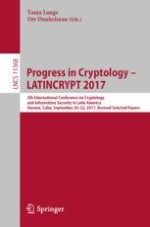2019 | OriginalPaper | Buchkapitel
Using Level-1 Homomorphic Encryption to Improve Threshold DSA Signatures for Bitcoin Wallet Security
verfasst von : Dan Boneh, Rosario Gennaro, Steven Goldfeder
Erschienen in: Progress in Cryptology – LATINCRYPT 2017
Aktivieren Sie unsere intelligente Suche, um passende Fachinhalte oder Patente zu finden.
Wählen Sie Textabschnitte aus um mit Künstlicher Intelligenz passenden Patente zu finden. powered by
Markieren Sie Textabschnitte, um KI-gestützt weitere passende Inhalte zu finden. powered by
